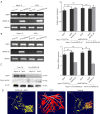Establishment and evaluation of cell and animal models expressing BORIS subfamily 2 variant
- PMID: 35813346
- PMCID: PMC9263788
- DOI: 10.21037/atm-21-6336
Establishment and evaluation of cell and animal models expressing BORIS subfamily 2 variant
Abstract
Background: The possibility of a cancer vaccine aimed at stimulating or mobilizing the body's immune system to control and kill tumor cells is emerging as a potential new strategy for tumor immunological therapy. CCCTC-binding Factor Like (CTCFL)/Brother of the Regulator of Imprinted Sites (BORIS), a cancer-testis antigen (CTA), has 23 mRNA splice variants classified into six subfamilies (sfs) and potentially encodes 17 distinct polypeptides. Based on our previous long-term research on hepatocellular carcinoma (HCC), we were particularly interested in whether BORIS sf2 could be a promising candidate for immunotherapy targeting liver cancer cells. Therefore, in this study, we aimed to construct an animal model to study the immunogenicity of human BORIS sf2 in murine hepatoma cells.
Methods: We established a hepatoma cell line expressing human BORIS sf2/C68 by inserting the sequences into a lentiviral vector pLVX-EF1α-IRES-Puro carrying the puromycin resistance gene. We achieved the stabilized expression of BORIS sf2/C68 in the oncogenic Hepa1c1c7 cells through lentivirus-mediated approach. The Hepa1c1c7 cells expressing the BORIS sf2/C68 (5×106/mouse) were inoculated subcutaneously into 6-week-old C57BL/6 mice to induce the formation of tumors.
Results: In the tumor formation experiment, the murine hepatoma cells expressing human BORIS sf2/C68 showed progressive growth in C57BL/6 mice. The animal model we constructed could be used to study the in vivo immunogenicity of the human BORIS sf2 in murine hepatoma cells.
Conclusions: The animals bearing BORIS sf2/C68-positive tumors may serve as an animal model for studying the therapeutic potency and safety of HCC vaccine directed at the CT-antigen BORIS sf2.
Keywords: BORIS sf2; Brother of the Regulator of Imprinted Sites (BORIS); animal model; cell model; murine hepatoma cell.
2022 Annals of Translational Medicine. All rights reserved.
Conflict of interest statement
Conflicts of Interest: All authors have completed the ICMJE uniform disclosure form (available at https://atm.amegroups.com/article/view/10.21037/atm-21-6336/coif). The authors have no conflicts of interest to declare.
Figures





Similar articles
-
BORIS variant SF2(C2/A4) promotes the malignant development of liver cancer by activating epithelial-mesenchymal transition and hepatic stellate cells.Mol Carcinog. 2023 Jun;62(6):731-742. doi: 10.1002/mc.23520. Epub 2023 Mar 17. Mol Carcinog. 2023. PMID: 36929051
-
Brother of the regulator of the imprinted site (BORIS) variant subfamily 6 is involved in cervical cancer stemness and can be a target of immunotherapy.Oncotarget. 2016 Mar 8;7(10):11223-37. doi: 10.18632/oncotarget.7165. Oncotarget. 2016. PMID: 26849232 Free PMC article.
-
A Therapeutic Vaccine Targeting Rat BORIS (CTCFL) for the Treatment of Rat Breast Cancer Tumors.Int J Mol Sci. 2023 Mar 22;24(6):5976. doi: 10.3390/ijms24065976. Int J Mol Sci. 2023. PMID: 36983050 Free PMC article.
-
Targeting CTCFL/BORIS for the immunotherapy of cancer.Cancer Immunol Immunother. 2018 Dec;67(12):1955-1965. doi: 10.1007/s00262-018-2251-8. Epub 2018 Nov 2. Cancer Immunol Immunother. 2018. PMID: 30390146 Free PMC article. Review.
-
Expression of the epigenetic factor BORIS (CTCFL) in the human genome.J Transl Med. 2011 Dec 14;9:213. doi: 10.1186/1479-5876-9-213. J Transl Med. 2011. PMID: 22168535 Free PMC article. Review.
References
-
- Loukinov DI, Pugacheva E, Vatolin S, et al. BORIS, a novel male germ-line-specific protein associated with epigenetic reprogramming events, shares the same 11-zinc-finger domain with CTCF, the insulator protein involved in reading imprinting marks in the soma. Proc Natl Acad Sci U S A 2002;99:6806-11. 10.1073/pnas.092123699 - DOI - PMC - PubMed
LinkOut - more resources
Full Text Sources
Research Materials
